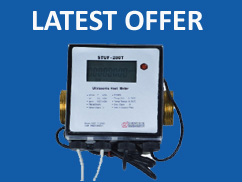
Have a question? Talk to our Expert at
Tel: 888-738-0188

How to Select a Liquid Ultrasonic Flowmeter
A. Ultrasonic Flowmeter Classification Liquid ultrasonic flowmeters can be classified in many ways: (1) Based-on principle: Transit-time vs. Doppler A transit-time flowmeter is based on the time difference between upstream and downstream sound propagation intervals. It usually provides very good accuracy (±1%). The former works well for clean flow or flow with minor particles. Applications include pure water, sea water, wash water, sewage, process liquids, oils, chemicals, and any homogeneous liquids which are capable of ultrasonic wave propagation. A Doppler flowmeter is based on the Doppler effect. It works well with suspension flow where particle concentration is above 100ppm and particle size is larger than 100um, but less than 10% in concentration. Doppler is easier to make and less accurate (±5%), thus, it is cheaper than transit-time flowmeter. Another not so popular flowmeter is cross-correlation based ultrasonic flowmeter. It works better for suspension flow or turbulent gas flow. (2) Based-on portability: Handheld vs. Wall-mount Handheld (or portable) flowmeer is very good for flow survey, HVAC and many applications where mobility is a concern. Another trend of using handheld flowmeter instead of wall-mount flowmeter is to save cost, since some handheld flowmeters (such as STUF-200H) can also be deployed as long-term measurement device if the environment is accommodating. Wall-mount (or fixed installation) flowmeter is more suitable for applications such as process control and long-term continuous flow monitoring. The instrument enclosure is normally weather-resistant or explosive-proof. Wall-mount is normally cheaper than handheld because it is usually ordered in large quantity. (3) Based-on transducer installation: Clamp-on vs. Wetted (Insertion and Flow Cell) Clamp-on flowmeter is non-intrusive, easy to install and easy to maintain. The transducers are mounted out side of a pipe, thus, no need to cut the pipe or to drill holes on the pipe, and there is no direct contact thus no pollution to the liquid, no pressure drop, etc. Wetted flowmeter comes with two varieties, insertion and flow cell. Insertion flowmeter requires to dill holes on the pipe wall to install the transducers. Flow cell, also called spool-piece, needs to be installed in line with the pipe, thus needs pipe fitting, etc. The transducers are pre-installed on the flow cell, thus, installation error has been reduced to minimum. In general, wetted transducer has better accuracy and better long-term stability than clamp-on type, but it might be more expensive. Comparing with conventional flowmeters, wetted type does not have moving parts, no interference to flow profile, no pressure drop and needs very little maintenance. (4) Based-on transducer scheme: Single-path vs. Multi-Path Single-path flowmeter utilizes one pair of transducers to form one ultrasonic path to intercept the flow in a pipe. It is suitable for small and medium size pipes. For large pipe size and very high accuracy needs, multi-path transducer installation may be considered. However, a multi-path flowmeter is much more expensive than a single-path flowmeter. It is usually used in custody transfer where accuracy is extremely important. B.Ultrasonic Flowmeter Selection Guide The most commonly used ultrasonic flowmer is transit-time based single-path flowmeter due to its high accuracy and reasonable cost. Depending on the applications, the selection of the right type of flowmeter may vary. You may need to answer the following questions before making the final decision:
The above questions seem overwhelming if this is the first time you are looking for a ultrasonic flowmter. Please do not be scared. Most likely, a simple clamp-on transit time handheld flowmeter or wall-mount flowmeter will suit your application. If not, please feel free to contact us for detailed suggestions. In the past few years, ultrasonic flowmeter price has been going down significantly. However, it is still expensive comparing with conventional flowmeters. In order to win the market over conventional flowmeters, a revolutionary price reduction must be achieved. The good news is that this kind of low cost, high quality products have already been taken off to the market. The Guaranteed high quality, guaranteed lowest price policy offered by Shenitech is particularly attractive. Click Here for more information. |
|